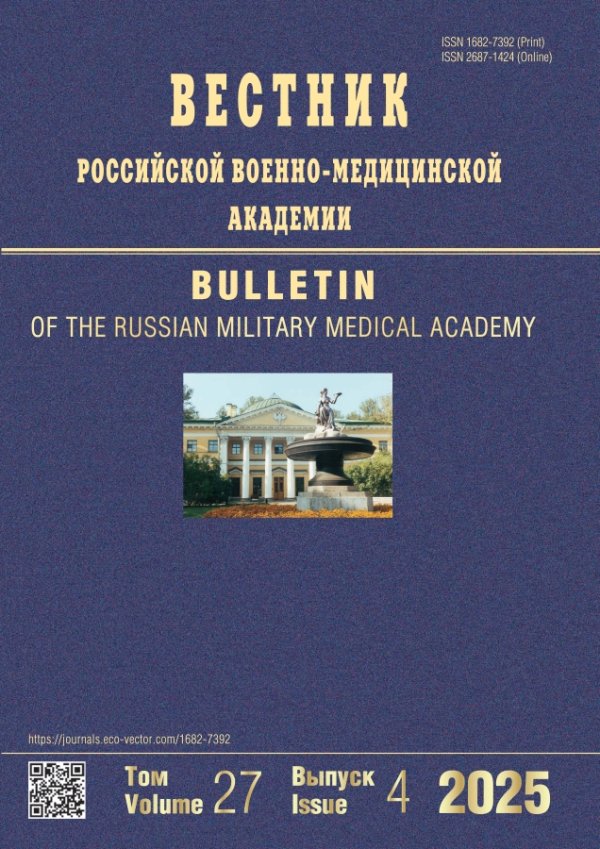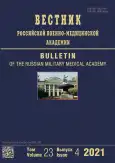Unintentional bile duct injuries: prevention and treatment
- Authors: Pryadko A.S.1,2, Romashchenko P.N.1, Sedletsky R.R.2, Aliev A.K.1, Yaraliev V.M.1
-
Affiliations:
- Military Medical Academy named after S.M. Kirov of the Ministry of Defense of the Russian Federation
- Leningrad Regional Clinical Hospital
- Issue: Vol 23, No 4 (2021)
- Pages: 47-54
- Section: Clinical trials
- URL: https://journal-vniispk.ru/1682-7392/article/view/79620
- DOI: https://doi.org/10.17816/brmma79620
- ID: 79620
Cite item
Abstract
Presented herein is a rational program of prevention, diagnosis, and the surgical treatment of patients with the unintentional bile duct injuries. Examination results and surgical treatment of 1,117 patients, who underwent laparoscopic cholecystectomy for acute and chronic cholecystitis from 2005−2020, were studied. The criteria for inclusion in the study were “difficult” laparoscopic cholecystectomy (181 medical histories) and unintentional bile duct injuries resulting from laparoscopic cholecystectomy (95 patients). Laparoscopic cholecystectomy with a duration of > 60 min was considered “difficult”. A total of 181 (17.7%) medical cases with “difficult” laparoscopic cholecystectomy and 95 patients with unintentional bile duct injuries were selected for this study. Instrumental studies were performed using X-ray contrast techniques such as: percutaneous fistulography, percutaneous-transhepatic, or intraoperative cholangiography, as well as relaparoscopy, ultrasound, endoscopic retrograde, or magnetic resonance cholangiopancreatography. A program approach to assist the patients with cholelithiasis was developed. Program implementation allows timely prevention and diagnosis of the unintentional bile duct injuries with minimal postoperative complications. The identification of the risk factors for “difficult” laparoscopic cholecystectomy indicates the need to comply with the preventive measures to prevent unintentional bile duct injuries and dictates the implementation of the surgical intervention by the most experienced surgeons from the second or third-level medical organizations. The rational option of surgical intervention aimed to eliminate the biliary tract injuries based on the following assessment criteria: general somatic condition of the patient, presence of the infectious complications, damage scale, crossed duct diameter, damage mechanism, and damage to the vessel. The right choice of the surgical intervention ensures a reduction in the number of complications and mortality, and quality of life improvement in patients with the unintentional bile duct injuries.
Full Text
##article.viewOnOriginalSite##About the authors
Andrey S. Pryadko
Military Medical Academy named after S.M. Kirov of the Ministry of Defense of the Russian Federation; Leningrad Regional Clinical Hospital
Author for correspondence.
Email: pradko66@mail.ru
ORCID iD: 0000-0002-7848-6704
SPIN-code: 2684-3990
candidate of medical sciences
Russian Federation, Saint PetersburgPavel N. Romashchenko
Military Medical Academy named after S.M. Kirov of the Ministry of Defense of the Russian Federation
Email: romashchenko@rambler.ru
ORCID iD: 0000-0001-8918-1730
SPIN-code: 3850-1792
doctor of medical sciences, professor
Russian Federation, Saint PetersburgRostislav R. Sedletsky
Leningrad Regional Clinical Hospital
Email: sedletsky@mail.ru
head of oncology department
Russian Federation, Saint PetersburgArsen K. Aliev
Military Medical Academy named after S.M. Kirov of the Ministry of Defense of the Russian Federation
Email: arsik-0587@mail.ru
ORCID iD: 0000-0001-5923-8804
SPIN-code: 1259-3231
candidate of medical sciences
Russian Federation, Saint PetersburgVagif M. Yaraliev
Military Medical Academy named after S.M. Kirov of the Ministry of Defense of the Russian Federation
Email: vag.1991@mail.ru
ORCID iD: 0000-0003-0966-0083
SPIN-code: 5530-3033
head of the department of purulent surgery
Russian Federation, Saint PetersburgReferences
- Ревишвили А.Ш., Кригер А.Г., Вишневский В.А., и др. Актуальные вопросы хирургии поджелудочной железы // Хирургия. Журнал им. Н.И. Пирогова. 2018. № 9. С. 5–14. doi: 10.17116/hirurgia20180915
- Rahman A., O’Connor D.B., Gather F., et al. Clinical classification and severity scoring systems in chronic pancreatitis: a systematic review // Dig Surg. 2020. Vol. 37, No. 3. P. 181–191. doi: 10.1159/000501429
- Прядко А.С., Майстренко Н.А., Ромащенко П.Н. Выбор варианта хирургического лечения хронического панкреатита с учетом морфологических изменений в поджелудочной железе // Вестник хирургии им. И.И. Грекова. 2014. Т. 173, № 3. С. 38–48. doi: 10.24884/0042-4625-2014-173-3-38-48
- Гальперин Э.И. Хронический панкреатит // Анналы хирургической гепатологии. 2009. Т. 14, № 3. С. 92–110.
- Коханенко Н.Ю., Артемьева Н.Н., Петрик С.В., и др. Двухэтапное лечение осложненного хронического панкреатита // Детская медицина Северо-Запада. 2018. Т. 7, № 1. С. 169.
- Хатьков И.Е., Цвиркун В.В., Израилов Р.Е., и др. Лапароскопические операции на поджелудочной железе: 11-летний опыт специализированного центра // Альманах клинической медицины. 2018. Т. 46, № 6. С. 640–647. doi: 10.18786/2072-0505-2018-466-640-647
- Conwell D.L., Lee L.S., Yadav D., et al. American pancreatic association practice guidelines in chronic pancreatitis evidence-based report on diagnostic guidelines // Journal of Pancreas. 2014. Vol. 43, No. 8. P. 1143–1162. doi: 10.1097/MPA.0000000000000237
- Beger H.G., Matsuno S., Cameron J.L. Diseases of the Pancreas. Current Surgical Therapy. Würzburg: Springer-Verlag, 2008.
- Гриневич В.Б., Майстренко Н.А., Прядко А.С., и др. Проблема хронического панкреатита с позиций терапевта и хирурга // Медицинский академический журнал. 2012. Т. 12, № 2. С. 35–55.
- Ромащенко П.Н., Прядко А.С., Бойко И.Ю., и др. Хронический панкреатит. Терминология, классификация, алгоритм обследования и стратегия хирургического лечения // Клиническая эндоскопия. 2018. № 1(52). С. 40–48.
- William D., Owens M.D. American Society of anesthesiologist’s physical status classification system is not a risk classification system // Anesthesiology. 2001. Vol. 94, No. 2. P. 378. doi: 10.1097/00000542-200102000-00042
Supplementary files









